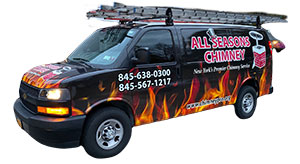All About Carbon Monoxide
One of the more dangerous by-products of combustion, carbon monoxide is a poisonous gas you do not want entering your home through your chimney and fireplace. Also known as the “silent killer,” carbon monoxide has no odor or color, so it can be impossible to know if you have a high level of carbon monoxide without a detector installed in your home. Most often, the first sign to the presence of this toxic gas in your house is the development of flu-like symptoms in members of your household, the first sign of carbon monoxide poisoning. All Seasons Chimney knows how to prevent carbon monoxide from even getting into your home and how to repair the damage causing the leaks of this gas. We would like to inform you about carbon monoxide and its dangers, with the help of the Chimney Safety Institute of America (CSIA).

It is called the “silent killer,” because only a detector installed in your home can let you know it is present.
According to the CSIA, carbon monoxide poisoning is responsible for the deaths of over 200 Americans every year, and approximately 10,000 injuries due to inhaling carbon monoxide are diagnosed annually. However, the symptoms of early exposure to carbon monoxide are extremely similar to those of the common cold and/or flu, such as sneezing, coughing, headaches, nausea, dizziness, and fatigue, and people can go for months without being officially diagnosed with carbon monoxide poisoning. If a person is exposed to carbon monoxide for a long enough period of time before being diagnosed, serious health issues can occur, such as brain damage and damage to the heart and other internal organs. If you ever develop long-term flu-like symptoms that linger, ask your doctor to give you a blood test that will check for carbon monoxide levels in your blood to properly diagnose you.
Why is carbon monoxide poisoning on the rise? Homes today are so much more airtight as people are going to greater efforts to seal off windows, doors, and other areas where air can leak inside, and this does not allow fresh air to enter the home. Nor does it let polluted air leave easily. Without air ventilation, furnaces and boilers are starved of the oxygen needed to burn fuel completely, producing carbon dioxide. Other causes of carbon dioxide entering your house through your chimney and fireplace include damaged, cracked, or deteriorated flue liners, creosote buildups, and animal or bird nests blocking your chimney flue.
You may be wondering how you can prevent carbon monoxide and other toxic gases from entering your home. According to many organizations including the CSIA, the US Consumer Product Safety Commission, the US Environmental Protection Agency, the American Lung Association, and the National Fire Protection Association all strongly recommend you practice proper maintenance of your fireplace and chimney by having them cleaned and inspected every year to prevent carbon monoxide leaks. To keep you and your family safe from the dangers of death by carbon monoxide poisoning, have your chimney swept once of year by a CSIA-certified company like All Seasons Chimney.
If you have more questions about carbon monoxide poisoning, contact All Seasons Chimney today to get our professional and expert advice about keeping your house safe from this toxic gas.

